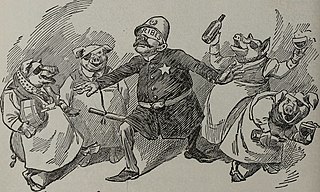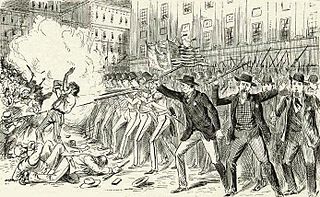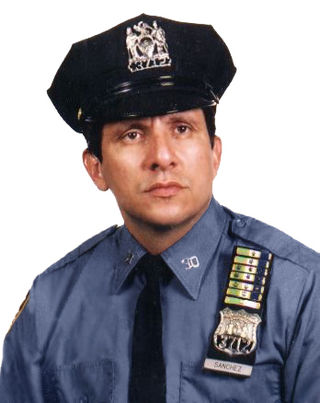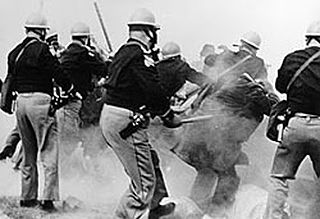Police perjury, sometimes euphemistically called "testilying", is the act of a police officer knowingly giving false testimony. It is typically used in a criminal trial to "make the case" against defendants believed by the police to be guilty when irregularities during the suspects' arrest or search threaten to result in their acquittal. It also can be extended to encompass substantive misstatements of fact to convict those whom the police believe to be guilty, procedural misstatements to "justify" a search and seizure, or even the inclusion of statements to frame an innocent citizen. More generically, it has been said to be "[l]ying under oath, especially by a police officer, to help get a conviction."

Police brutality is the excessive and unwarranted use of force by law enforcement against an individual or a group. It is an extreme form of police misconduct and is a civil rights violation. Police brutality includes, but is not limited to, asphyxiation, beatings, shootings, improper takedowns, and unwarranted use of tasers.

Police corruption is a form of police misconduct in which law enforcement officers end up breaking their political contract and abusing their power for personal gain. This type of corruption may involve one or a group of officers. Internal police corruption is a challenge to public trust, cohesion of departmental policies, human rights and legal violations involving serious consequences. Police corruption can take many forms, such as: bribery, theft, sexual assault, and discrimination.
The Commission of Inquiry into Possible Illegal Activities and Associated Police Misconduct into Queensland Police corruption was a judicial inquiry presided over by Tony Fitzgerald QC. The inquiry resulted in the resignation of Queensland's premier, Joh Bjelke-Petersen, the calling of two by-elections, and the jailing of three former ministers and the Police Commissioner Terry Lewis. It also contributed to the end of the National Party of Australia's 32-year run as the governing political party in Queensland.

Law enforcement in Australia is one of the three major components of the country's justice system, along with courts and corrections. Law enforcement officers are employed by all three levels of government – federal, state/territory, and local.

The Rampart scandal was a police corruption scandal which unfolded in Los Angeles, California, United States, during the late 1990s and early 2000s. The scandal concerned widespread criminal activity within the Community Resources Against Street Hoodlums (CRASH) anti-gang unit of the Los Angeles Police Department's Rampart Division. More than 70 police officers were initially implicated in various forms of misconduct, including unprovoked shootings and beatings, planting of false evidence, stealing and dealing narcotics, bank robbery, perjury, and cover-ups thereof.
The Mollen Commission is formally known as The City of New York Commission to Investigate Allegations of Police Corruption and the Anti-Corruption Procedures of the Police Department. Former judge Milton Mollen was appointed in June 1992 by then New York City mayor David N. Dinkins to investigate corruption in the New York City Police Department. Mollen's mandate was to examine and investigate "the nature and extent of corruption in the Department; evaluate the department's procedures for preventing and detecting that corruption; and recommend changes and improvements to those procedures".
Police misconduct is inappropriate conduct and illegal actions taken by police officers in connection with their official duties. Types of misconduct include among others: sexual offences, coerced false confession, intimidation, false arrest, false imprisonment, falsification of evidence, spoliation of evidence, police perjury, witness tampering, police brutality, police corruption, racial profiling, unwarranted surveillance, unwarranted searches, and unwarranted seizure of property.

As of 2020, more than 800,000 sworn law enforcement officers have been serving in the United States. About 137,000 of those officers work for federal law enforcement agencies.

The Commission to Investigate Alleged Police Corruption was a five-member panel initially formed in April 1970 by Mayor John V. Lindsay to investigate corruption within the New York City Police Department. The creation of the commission was largely a result of the publicity generated by the public revelations of police corruption made by Patrolman Frank Serpico and Sergeant David Durk. The commission concluded that the NYPD had systematic corruption problems, and made a number of recommendations.

Percy Whitman Knapp was a United States district judge of the United States District Court for the Southern District of New York. Previous to that service, he led a far-reaching investigation into corruption in the New York City Police Department from 1970 to 1972.
Police accountability involves holding both individual police officers, as well as law enforcement agencies responsible for effectively delivering basic services of crime control and maintaining order, while treating individuals fairly and within the bounds of law. Police are expected to uphold laws, regarding due process, search and seizure, arrests, discrimination, as well as other laws relating to equal employment, sexual harassment, etc. Holding police accountable is important for maintaining the public's "faith in the system". Research has shown that the public prefers independent review of complaints against law enforcement, rather than relying on police departments to conduct internal investigations. There is a suggestion that such oversight would improve the public's view on the way in which police officers are held accountable.

The New York City Police Department (NYPD) originates in the Government of New York City attempts to control rising crime in early- to mid-19th-century New York City. The City's reforms created a full-time professional police force modeled upon London's Metropolitan Police, itself only formed in 1829. Established in 1845, the Municipal Police replaced the inadequate night watch system which had been in place since the 17th century, when the city was founded by the Dutch as New Amsterdam.

Throughout the history of the New York City Police Department, numerous instances of corruption, misconduct, and other allegations of such, have occurred. Over 12,000 cases have resulted in lawsuit settlements totaling over $400 million during a five-year period ending in 2014. In 2019, misconduct lawsuits cost the taxpayer $68,688,423, a 76 percent increase over the previous year, including about $10 million paid out to two exonerated individuals who had been falsely convicted and imprisoned.

Joe Sánchez , is a former New York City police officer and author who published books about corruption within the New York City Police Department (NYPD).

Police brutality is the use of excessive or unnecessary force by personnel affiliated with law enforcement duties when dealing with suspects and civilians.
Robert Leuci was a detective with the New York City Police Department (NYPD), known for his work exposing corruption in the police department and the criminal justice system.
The Dirty Thirty was a police corruption conspiracy that took place between 1992 and 1995 in the New York City Police Department's 30th Precinct, serving Harlem, and resulted in the largest collection of police officers charged with corruption in New York City in almost a decade. A group of rogue officers, led by Sergeant Kevin P. Nannery, participated in various unlawful activities, including civil rights conspiracy, perjury, extortion, grand larceny and the possession and distribution of narcotics. The scandal led to a number of arrests of police officers and two suicides.
Noble cause corruption is corruption caused by the adherence to a teleological ethical system, suggesting that people will use unethical or illegal means to attain desirable goals, a result which appears to benefit the greater good. Where traditional corruption is defined by personal gain, noble cause corruption forms when someone is convinced of their righteousness, and will do anything within their powers to achieve the desired result. An example of noble cause corruption is police misconduct "committed in the name of good ends" or neglect of due process through "a moral commitment to make the world a safer place to live." The knowing misconduct by a law enforcement officer or prosecutor with the goal of attaining what the officer believes is a "just" result.

Police reform in the United States is an ongoing political movement that seeks to reform systems of law enforcement throughout the United States. Many goals of the police reform movement center on police accountability. Specific goals may include: lowering the criminal intent standard, limiting or abolishing qualified immunity for law enforcement officers, sensitivity training, conflict prevention and mediation training, updating legal frameworks, and granting administrative subpoena power to the U.S. Department of Justice for "pattern or practice" investigations into police misconduct and police brutality.










